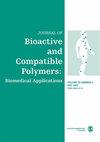A silk fibroin scaffold that accelerates both biodegradation and cell proliferation by incorporating sericin
IF 2.1
4区 生物学
Q3 BIOTECHNOLOGY & APPLIED MICROBIOLOGY
引用次数: 0
Abstract
When 3D silk fibroin scaffolds are used for the regeneration of soft tissues with fast regeneration rates, such as skin dermis, one concern is to accelerate the biodegradation of scaffolds and to match the degradation rate of scaffolds with the regeneration rate of tissues. In this study, sericin was incorporated into 3D silk fibroin scaffolds through crosslinking and followed by freeze-drying. The effects of incorporating sericin on the pore wall microstructure within the scaffolds, the biodegradability of scaffolds and cell proliferation within scaffolds were investigated. It was found that a large number of secondary pores and nanoscale particles were generated on the pore walls within the scaffolds due to the incorporation of sericin and that the number of secondary pores and the size of the particles increased with increasing sericin proportion. The results of in vitro biodegradation and coculture with human umbilical vein vascular endothelial cells demonstrated that the incorporation of sericin not only significantly accelerated the degradation of 3D silk fibroin scaffolds, but also promoted cell adhesion and proliferation. The secondary pores and particles generated on the pore walls inside the fibroin/sericin hybrid scaffolds had a positive contribution to promoting cell adhesion and proliferation. This study provides a biocompatible method for the modification of silk fibroin scaffolds, which can not only accelerate the biodegradation of the scaffold but also promote the adhesion and proliferation of seeded cells.一种丝素蛋白支架,通过结合丝胶蛋白加速生物降解和细胞增殖
3D丝素蛋白支架用于皮肤真皮层等再生速度快的软组织再生时,需要关注的一个问题是如何加快支架的生物降解速度,并使支架的降解速度与组织的再生速度相匹配。本研究通过交联将丝胶蛋白掺入三维丝素蛋白支架中,并进行冷冻干燥。研究了丝胶对支架孔壁微观结构、支架可生物降解性及支架内细胞增殖的影响。结果表明,丝胶的掺入使支架内部孔壁上产生了大量的次生孔隙和纳米级颗粒,并且随着丝胶掺入比例的增加,次生孔隙的数量和颗粒的大小也随之增加。体外生物降解及与人脐静脉血管内皮细胞共培养的结果表明,丝胶蛋白的掺入不仅显著加速了三维丝素蛋白支架的降解,而且促进了细胞的粘附和增殖。丝胶蛋白/丝胶蛋白杂交支架内孔壁上产生的次生孔隙和颗粒对促进细胞粘附和增殖有积极的贡献。本研究为丝素蛋白支架的修饰提供了一种生物相容性的方法,不仅可以加速支架的生物降解,还可以促进种子细胞的粘附和增殖。
本文章由计算机程序翻译,如有差异,请以英文原文为准。
求助全文
约1分钟内获得全文
求助全文
来源期刊

Journal of Bioactive and Compatible Polymers
工程技术-材料科学:生物材料
CiteScore
3.50
自引率
0.00%
发文量
27
审稿时长
2 months
期刊介绍:
The use and importance of biomedical polymers, especially in pharmacology, is growing rapidly. The Journal of Bioactive and Compatible Polymers is a fully peer-reviewed scholarly journal that provides biomedical polymer scientists and researchers with new information on important advances in this field. Examples of specific areas of interest to the journal include: polymeric drugs and drug design; polymeric functionalization and structures related to biological activity or compatibility; natural polymer modification to achieve specific biological activity or compatibility; enzyme modelling by polymers; membranes for biological use; liposome stabilization and cell modeling. This journal is a member of the Committee on Publication Ethics (COPE).
 求助内容:
求助内容: 应助结果提醒方式:
应助结果提醒方式:


